
Dianthus caryophyllus, commonly known as carnation or clove pink, is a species of Dianthus native to the Mediterranean region. Its exact natural range is uncertain due to extensive cultivation over the last 2,000 years. Carnations are prized for their vibrant colors, delicate fringed petals, and enchanting fragrance.
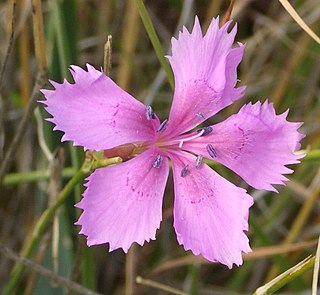
Dianthus is a genus of about 340 species of flowering plants in the family Caryophyllaceae, native mainly to Europe and Asia, with a few species in north Africa and in southern Africa, and one species in arctic North America. Common names include carnation, pink and sweet william.

Dianthus chinensis, commonly known as rainbow pink or China pink is a species of Dianthus native to northern China, Korea, Mongolia, and southeastern Russia. It is a herbaceous perennial plant growing to 30–50 cm tall.

Dianthus barbatus, the sweet William, is a species of flowering plant in the family Caryophyllaceae, native to southern Europe and parts of Asia. It has become a popular ornamental garden plant. It is a herbaceous biennial or short-lived perennial plant growing to 13–92 cm tall, with flowers in a dense cluster of up to 30 at the top of the stems. Each flower is 2–3 cm diameter with five petals displaying serrated edges. Wild plants produce red flowers with a white base, but colours in cultivars range from white, pink, red, and purple to variegated patterns. The exact origin of its English common name is unknown but first appears in 1596 in botanist John Gerard's garden catalogue. The flowers are edible and may have medicinal properties. Sweet William attracts bees, birds, and butterflies.

Dianthus deltoides, the maiden pink, is a species of Dianthus native to most of Europe and western Asia. It can also be found in many parts of North America, where it is an introduced species.

Tulipa turkestanica, the Turkestan tulip, is a species of tulip native to Central Asia. It was first described by Eduard August von Regel in 1873 as a variety of T. sylvestris, then elevated to full species status two years later.

Nematanthus is a genus of flowering plants in the family Gesneriaceae. All of its species are endemic to Brazil. Compared to other gesneriads, Nematanthus has leaves that are small, succulent, and hard-surfaced. The plant has a trailing, branching, and spreading habit; it is generally an epiphyte in nature and a hanging-basket plant in cultivation. The flower has fused petals. In some species, the flower has a "pouch" at the bottom. The fancied resemblance of such flowers to a goldfish gives these plants the common name goldfish plant or guppy plant.

Aesculus parviflora, the bottlebrush buckeye or small-flowered buckeye, is a species of suckering deciduous shrub in the family Sapindaceae. The species is native to the southeastern United States, where it is found primarily in Alabama and Georgia, with a disjunct population in South Carolina along the Savannah River. Its natural habitat is in mesic forests, on bluffs and in ravines.
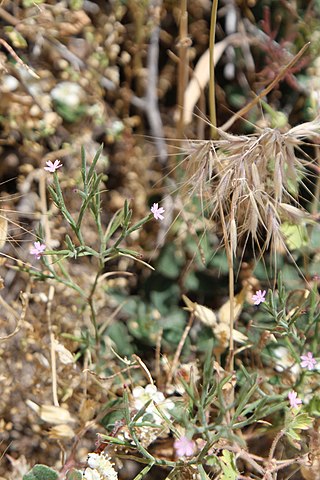
Dianthus nudiflorus, synonym Velezia rigida, is a species of flowering plant in the family Caryophyllaceae. It is native to the Mediterranean Basin countries of Europe and North Africa, and to western and central Asia and Pakistan. It is also present in northern California where it is an introduced species. It is an annual herb growing from a taproot and producing a hairy, glandular, branching green or purplish stem up to 40 centimeters tall. The linear leaves are up to 2 centimeters long. Solitary flowers occur in the leaf axils. Each flower has a very long, cylindrical, ribbed calyx of fused sepals forming the tubular throat of the flower, measuring at least a centimeter in length. At the top of the tube is the flower corolla which has five pink or purplish petals.
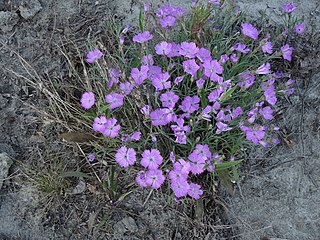
Dianthus repens, common names boreal carnation and northern pink, is a plant species native to the Nei Mongol region of China, as well as to Siberia, the Russian Far East, northern parts of European Russia, Alaska and Yukon Territory.
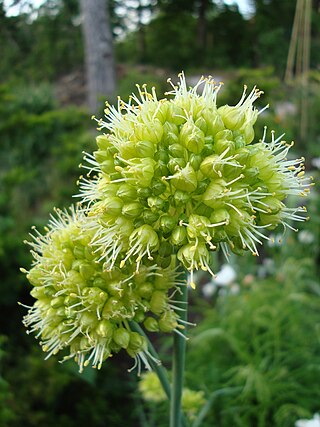
Allium obliquum, common name lop-sided onion or twisted-leaf onion, is a Eurasian species of wild onion with a range extending from Romania to Mongolia. It is also widely cultivated elsewhere as an ornamental.
Allium griffithianum is a species of flowering plant in the family Amaryllidaceae. It is an onion found in the high mountains of Pakistan, Afghanistan, Kyrgyzstan, Uzbekistan and Tajikistan. It is a perennial herb up to 40 cm tall, with a hemispherical umbel of flowers, white or light pink or pale purple.
Dianthus cyprius is a shrubby hairless perennial plant with overarching branches up to 90 cm long, the flowering branches growing from the sides of stems end in leaf-tufts. The Calyx-tube grows up to 2.5 cm cylindrical, with 4-9 pairs of bracts at the base. Flowers clustered, 2 cm in diameter; petals pink with some red marking toward the centre. Flowers from June to November. The plant's common name is "Dianthos o Kyprios".
Iris grossheimii is a plant species in the genus Iris, subgenus Iris and section Oncocyclus. It is a rhizomatous perennial, from the Caucasus mountains of Georgia, Armenia and Azerbaijan. It has sickle shaped leaves, which are as long as the short stem, which carries one flower in spring. It is beige, pink or brown covered in dark lines that are, purple-brown or brown. It has a large blackish brown signal patch and brown or black beard. It is rarely cultivated as an ornamental plant in temperate regions, as it needs very dry conditions during the summer.

Dianthus strictus, known as the wild pink, is a species of flowering plant in the family Caryophyllaceae.

Tulipa altaica is a species of tulip found in Russia, Kazakhstan, and China.
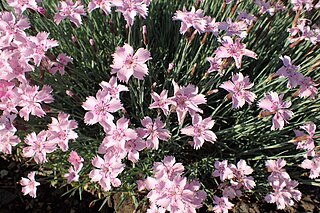
Dianthus plumarius, also known as the common pink, garden pink, wild pink or simply pink, is a species of flowering plant in the family Caryophyllaceae.

Dianthus basuticus, called the Drakensberg carnation, Lesotho carnation, Lesotho pink, hlokoa‑la‑tsela in the Sesotho language and Lesothose wilde angelier in Afrikaans, is a species of Dianthus native to South Africa and Lesotho.
Nathaliella is a monotypic genus of flowering plants belonging to the family Scrophulariaceae. The only species is Nathaliella alaica. It is also within Tribe Scrophularieae.

Dianthus thunbergii is a species of flowering plant in the family Caryophyllaceae.
















